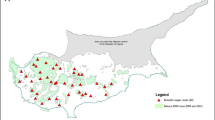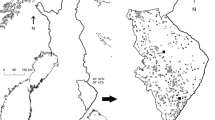Abstract
We examined inter-specific interactions among goshawks (Accipiter gentilis), common buzzards (Buteo buteo) and honey buzzards (Pernis apivorus) in western Finland in 1983–1996. Because goshawks are among the largest birds of prey species in boreal forests they may take over the nest of smaller and less-competitive forest-dwelling raptors when searching for suitable places for breeding. Accordingly, more than half of newly established goshawk territories were found on the territories previously occupied by the common buzzard and the honey buzzard. Otherwise, territory sharing between these species was rare. Fledgling production of honey buzzards was not associated with the presence of goshawks, probably owing to the almost 2 months later onset of breeding. This probably decreases competitive interactions between these two species. An intensive interference competition, instead, seemed to be evident between common buzzards and goshawks, because the fledgling production of common buzzards was decreased by 20% as a result of failures during incubation and nestling period in the vicinity (<1 km) of occupied goshawk nests. Similarly, territory occupancy of common buzzards till the next breeding season was significantly reduced in the presence of goshawks. Relatively high proportions of occupied buzzard territories (17%) in the study area were shared by breeding goshawks on the same territory. This suggests that although their diets are dissimilar they inhabit similar habitats and might compete for the available prime nesting habitats within forest landscapes. In addition, goshawks benefit from taking over the complete nests of other raptors, imposing upon the original owners of the nest, because building a large stick nest is probably energetically costly. As a large raptor, the goshawk apparently has a competitive advantage over smaller ones, and may have an ever-increasing impact on smaller birds of prey, if there is a lack of sheltered forests inducing competition for the available nest sites.
Similar content being viewed by others
References
Bolker BM, Pacala SW, Neuhauser C (2003) Spatial dynamics in model plant communities: what do we really know? Am Nat 162:135–148
Carey AB, Horton SP, Biswell BL (1992) Northern spotted owl: influence of prey base and landscape character. Ecol Monogr 62:223–250
Cramp S, Perrins CM (1993) Handbook of the birds of Europe, Middle east and North Africa—the birds of the Western Palearctic, vol 7. Oxford University Press, Oxford
Damgaard C (2004) Dynamics in a discrete two-species competition model: coexistence and over-compensation. J Theor Biol 227:197–203
Del Hoyo J, Elliott A, Sargatal J (eds) (1994) Handbook of the birds of the world, vol 2. New world vultures to guineafowls. Lynx, Barcelona
Dodds WK, Henerby GM (1995) Simulation of reponses of community structure to species interactions driven by phenotypic change. Ecol Model 79:85–94
Forsman D, Ehrsten B (1985) Is the goshawk declining (in Finnish with English summary)? Lintumies 20:83–88
Forsman ED, Meslow EC, Wright HM (1984) Distribution and biology of the spotted owl in Oregon. Wildl Monogr 87:1–64
Hakkarainen H, Korpimäki E (1996) Competitive and predatory interactions among raptors: an observational and experimental study. Ecology 77:1134–1142
Hakkarainen H, Ilmonen P, KoivunenV, Korpimäki E (2001) Experimental increase of predation risk induces breeding dispersal of Tengmalm’s owl. Oecologia 126:355–359
Hayward GD, Escano RE (1989) Goshawk nest-site characteristics in western Montana and Northern Idaho. Condor 91:476–479
Huitu O, Norrdahl K, Korpimäki E (2003) Landscape effects on temporal and spatial properties of vole population fluctuations. Oecologia 135:209–220
Itämies J, Mikkola H (1972) The diet of honey buzzards Pernis apivorus in Finland. Ornis Fenn 49:7–10
Kenward RE (1982) Goshawk hunting behaviour and range size as a function of food and habitat availability. J Anim Ecol 51:69–80
Kjellen N, Roos G (2000) Population trends in Swedish raptors demonstrated by migration counts at Falsterbo, Sweden 1942–1997. Bird Study 47:195–211
Korpimäki E (1987) Dietary shifts, niche relationships and reproductive output of coexisting kestrels and long-eared owls. Oecologia 74:277–285
Kostrzewa A (1991) Interspecific interference competition in three European raptor species. Ethol Ecol Evol 3:127–143
Kostrzewa A (1996) A comparative study of nest-site occupancy and breeding performance as indicators for nesting-habitat quality in three European raptor species. Ethol Ecol Evol 8:1–18
Kruger O (2002a) Interactions between common buzzard Buteo buteo and goshawk Accipiter gentilis: trade-offs revealed by a field experiment. Oikos 96:441–452
Kruger O (2002b) Analysis of nest occupancy and nest reproduction in two sympatric raptors: common buzzard Buteo buteo and goshawk Accipiter gentilis. Ecography 25:523–532
Kruger O, Stefener U (1996) Nahrungsökologie und Populationsdynamik des Habichts Accipiter gentilis im östlichen Westfalen. Wogelwelt 117:1–8
Martin TE (1986) Competition in breeding birds: on the importance of considering processes at the level of the individual. Curr Ornithol 4:181–210
Martin TE (1996) Fitness costs of resource overlap among coexisting bird species. Nature 380:338–340
Miller RS (1967) Pattern and process in competition. Adv Ecol Res 4:1–74
Miller RS (1969) Competition and species diversity. Brookhaven Symp Biol 22:63–70
Mouquet N, Leadley P, Meriguet J, Loraeau M (2004) Immigration and local competition in herbaceous plant communities: a three-year seed-sowing experiment. Oikos 104:77–90
Newton I (1979) Population ecology of raptors. Poyser, Berkhamsted
Newton I (1986) Lifetime reproductive output of female sparrowhawks. J Anim Ecol 54:241–253
Penteriani V (2002) Goshawk nesting habitat in Europe and North America: a review. Ornis Fenn 79:149–163
Reif V, Tornberg R, Jungell S, Korpimäki E (2001) Diet variation of common buzzards in Finland supports the alternative prey hypothesis. Ecography 24:267–274
Schoener TW (1984) Size differences among sympatric bird-eating hawks: a worldwide survey. In: Strong DR, Simberloff D, Abele LG, Thistle AB (eds) Ecological communities: conseptual issues and the evidence. Princeton University Press, N.J., pp 254–281
Sulkava S (1964) Zur Nahrungsbiologie des Habichts, Accipiter G. gentiles (L.). Aquilo Ser Zool 3:1–103
Temeles EJ (1985) Sexual size dimorphism of bird-eating hawks: the effect of prey vulnerability. Am Nat 125:485–499
Tornberg R, Sulkava S (1991) The effect of changing tetraonid populations on the nutrition and breeding success of the goshawk (Accipiter gentilis L.) in Northern Finland. Aquilo Ser Zool 28:23–33
Väisänen R, Lammi E, Koskimies P (1996) Muuttuva pesimälinnusto (in Finnish). Otava Keuruu
Widen P (1989) The hunting habitats of goshawks Accipiter gentilis in boreal forests of central Sweden. Ibis 131:205–231
Widen P (1997) How and why is the goshawk (Accipiter gentilis) affected by modern forest management in Fennoscandia? J Raptor Res 31:107–113
Wiens JA (1989) The ecology of bird communities, vol. 2. Process and variations. Cambridge University Press, Cambridge
Acknowledgements
We thank Petri Suorsa, Esa Huhta, Erkki Korpimäki and Jouni Sorvari for valuable comments on the manuscript. The study was financially supported by the Academy of Finland (to H. H.).
Author information
Authors and Affiliations
Corresponding author
Rights and permissions
About this article
Cite this article
Hakkarainen, H., Mykrä, S., Kurki, S. et al. Competitive interactions among raptors in boreal forests. Oecologia 141, 420–424 (2004). https://doi.org/10.1007/s00442-004-1656-6
Received:
Accepted:
Published:
Issue Date:
DOI: https://doi.org/10.1007/s00442-004-1656-6




